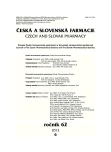Monitoring of formation of diclofenac sodium salt hydrates and their influence on the drug dissolution from prepared tablets
Authors:
Petr Doležel; Jan Muselík; Michaela Králová; David Vetchý
Published in:
Čes. slov. Farm., 2013; 62, 259-263
Category:
Original Articles
Overview
NIR spectroscopy together with multivariate data analysis were used to analyze the hydrates of diclofenac sodium prepared from the non-aqueous solvents tetrahydrofuran and methanol under standard laboratory conditions at 20 °C and relative humidity less than 60%. It was confirmed that the developed PLS regression model can monitor the process of formation of hydrates. It was also found that the hydrated form of diclofenac sodium arises during the preparation of the dosage form the using technology of impregnating the solid carrier by non-aqueous solvents, which resulted in reducing of the drug release rate from prepared tablets up to twice. NIR spectroscopy was confirmed as one of the effective PAT (Process Analytical Technology) methods.
Keywords:
process analytical technology method, PLS regression, NIR spectroscopy, hydrates, impregnation, diclofenac sodium
Sources
1. Bartolomei M., Rodomonte A., Antoniella E., Minelli G., Bertocchi P. Hydrate modifications of the non-steroidal anti-inflammatory drug diclofenac sodium: Solid-state characterisation of a trihydrate form. J Pharmaceut Biomed 2007; 45, 443–449.
2. Kou X., Chan L. W., Steckel H., Heng P. W. S. Physico-chemical aspects of lactose for inhalation. Adv Drug Deliver Rev 2012; 64, 220–232.
3. Karner S., Urbanetz N. A. The impact of electrostatic charge in pharmaceutical powders with specific focus on inhalation-powders. J Aerosol Sci 2011; 42, 428–445.
4. Bartolomei M., Bertocchi P., Antoniella E., Rodomonte A. Physico-chemical characterisation and intrinsic dissolution studies of a new hydrate form of diclofenac sodium: comparison with anhydrous form. J Pharmaceut Biomed 2006; 40, 1105–1113.
5. Muselík J. Aplikace blízké infračervené spektroskopie ve farmaceutické analýze. Chem Listy 2012; 106, 10–15.
6. Esbensen K. H. Multivariate Data Analysis – In Praktice, 5. vyd. CAMO Process AS 2004; 598.
7. Franc A., Rabišková M., Goněc R. Impregnation: a progressive method in the production of solid dosage forms with low content of poorly soluble drugs. Eur J Parent Pharm Sci 2011; 16, 85–93.
8. Franc A., Rabišková M., Goněc R. Impregnation method in the production of solid dosage forms containing low-dose poorly absorbable drugs. Ind Pharm 2011; 26, 7–9.
9. Llina’s A., Burley J. C., Box K. J., Glen R. C., Goodman J. M. Diclofenac Solubility: Independent determination of the intrinsic solubility of three crystal forms. J Med Chem 2007; 50, 979–983.
10. Gastaldi D., Canonico F., Irico S., Pellerej D., Paganini M. C. Near-infrared spectroscopy investigation on the hydration degree of a cement paste. J Mater Sci 2010; 45, 3169–3174.
Labels
Pharmacy Clinical pharmacologyArticle was published in
Czech and Slovak Pharmacy

2013 Issue 6
Most read in this issue
- A view on providing care in the field of medicines in Slovakia – the pharmacist and the patient
- Alkalimetric titrations of salts of organic bases in the Pharmacopoeia
- Influence of quaternary ammonium salt on liberation of drug with antiseptic effect
- Physiological factors with impact on the drug behaviour in the gastrointestinal tract
